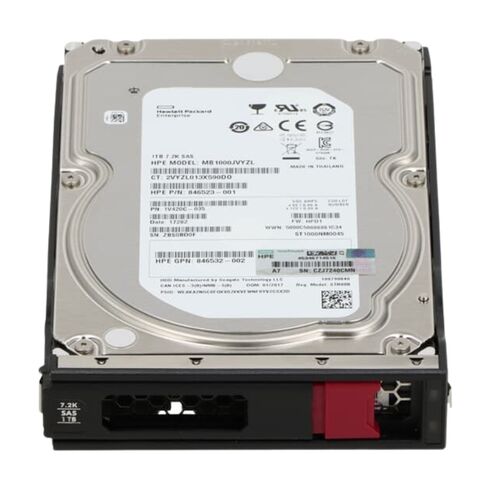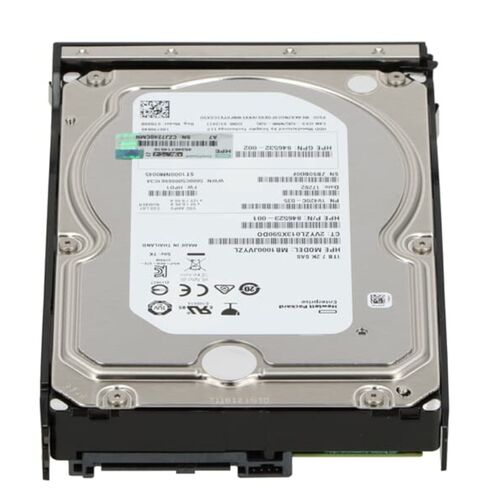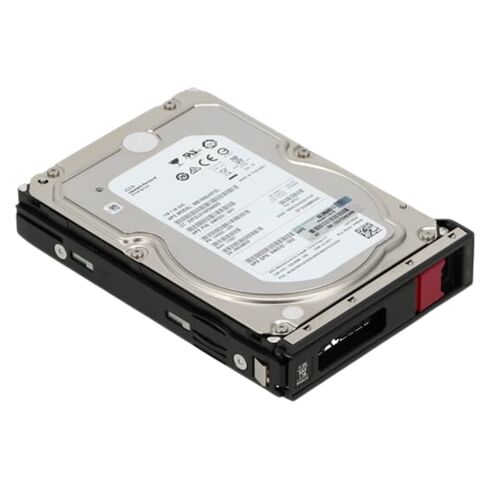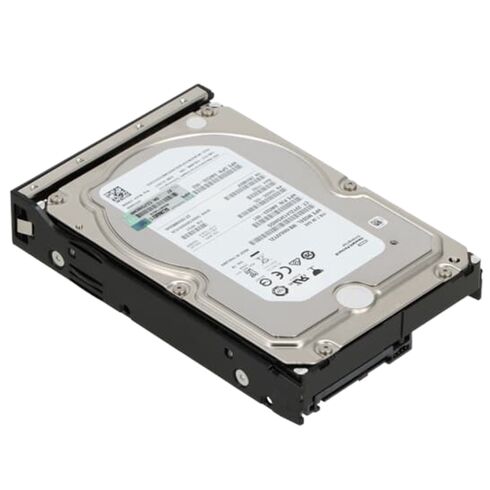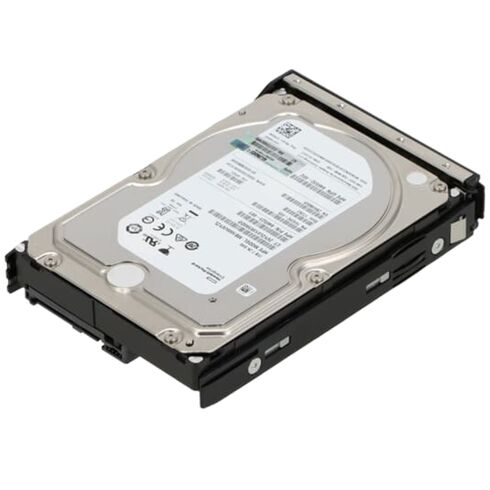846526-X21 HPE 1TB 7.2K RPM SAS 12GBPS Hard Drive
- — Free Ground Shipping
- — Min. 6-month Replacement Warranty
- — Genuine/Authentic Products
- — Easy Return and Exchange
- — Different Payment Methods
- — Best Price
- — We Guarantee Price Matching
- — Tax-Exempt Facilities
- — 24/7 Live Chat, Phone Support
- — Visa, MasterCard, Discover, and Amex
- — JCB, Diners Club, UnionPay
- — PayPal, ACH/Bank Transfer (11% Off)
- — Apple Pay, Amazon Pay, Google Pay
- — Buy Now, Pay Later - Affirm, Afterpay
- — GOV/EDU/Institutions PO's Accepted
- — Invoices
- — Deliver Anywhere
- — Express Delivery in the USA and Worldwide
- — Ship to -APO -FPO
- — For USA - Free Ground Shipping
- — Worldwide - from $30
Specifications Overview
- Brand: HPE
- Part Number: 846526-X21
- Spare Part Number: 846613-001
- Model Number: MB1000JVYZL
- Assembly Number: 846523-001
- HPE GPN: 845532-002
Device Features
General Specifications
- Device Type: Hot-swappable hard drive
- Storage Capacity: 1 TB
- Form Factor: 3.5-inch Low Profile LFF
- Interface: SAS 12 Gbps
- Drive Technology: Air-based filling technology
- Plug Type: Hot Pluggable
- Format Type: 512n format
- Carrier Type: Low Profile Carrier (LPC)
- Firmware: Digitally Signed Firmware with Advanced Format 512n
- Workload Type: Midline
- Bundling: HPE Low Profile Carrier included
Performance Capabilities
Transfer Rates and Speeds
- Data Transfer Rate: 12 Gb/sec (external)
- Spindle Speed: 7200 RPM
- Max Sequential Throughput: 200 MiB/s
Random IOPS Performance
- 128KiB Random Read (IOPs): 110
- 128KiB Random 70% Read / 30% Write (IOPs): 110
- 128KiB Random 50% Read / 50% Write (IOPs): 110
Expansion and Connectivity
Interface & Bay Compatibility
- Interface: 1 x SAS 12 Gb/s
- Compatible Bay Size: 3.5" Large Form Factor (LFF)
Power Efficiency
Power Consumption
- Idle Power: 2.60 Watts
- Random Read: 3.60 Watts
- Random Write: 3.60 Watts
- Sequential Read: 4.40 Watts
- Sequential Write: 3.90 Watts
System Compatibility
Designed For:
- HPE Apollo Series: 4200 Gen9 (3.5 inch)
- HPE ProLiant DL Series: DL120 Gen9, DL120 Gen9 Entry, DL180 Gen9, DL180 Gen9 Base, DL180 Gen9 Entry, DL180 Gen9 Storage, DL20 Gen10, DL20 Gen10 Entry, DL20 Gen10 Performance, DL20 Gen10 solution, DL20 Gen9, DL20 Gen9 Entry, DL20 Gen9 Performance, DL60 Gen9, DL60 Gen9 Base, DL60 Gen9 Entry, DL80 Gen9, DL80 Gen9 Base, DL80 Gen9 Entry (3.5 inch)
- HPE ProLiant ML Series: ML150 Gen9, ML150 Gen9 Base, ML150 Gen9 Entry, ML150 Gen9 Performance, ML30 Gen10, ML30 Gen10 Entry, ML30 Gen10 Performance, ML30 Gen10 Solution, ML350 Gen10, ML350 Gen10 Base, ML350 Gen10 Entry, ML350 Gen10 High Performance, ML350 Gen10 Performance, ML350 Gen10 SMB, ML350 Gen10 Solution, ML350 Gen10 Special Server, ML350 Gen10 Sub-Entry (3.5 inch)
Capacity: 1TB
The HPE 846526-X21 Hard Drive is equipped with a generous capacity of 1TB, making it an excellent choice for individuals and businesses alike. With this immense storage space, users can store a vast amount of data, including documents, photos, videos, and much more. Whether you need to store important business files or create a backup of your personal data, the 1TB capacity ensures you have ample room to accommodate your needs.
Benefits of 1TB Capacity
1. Ample Storage Space: The primary advantage of the 1TB capacity is the ability to store a significant amount of data without worrying about running out of space. This is particularly beneficial for professionals who deal with large files or organizations that require extensive data storage.
2. Versatility: The 1TB capacity allows users to store various types of data, including multimedia files, software installations, databases, and more. It provides the flexibility to manage a diverse range of applications and ensures that users have sufficient space for their data-intensive tasks.
3. Convenience: With the 1TB capacity, you can conveniently keep all your important files and documents in one place. This eliminates the hassle of managing multiple drives or constantly transferring files between storage devices. It simplifies data organization and retrieval, saving you valuable time and effort.
Importance of 1TB Capacity
1. Business Efficiency: For businesses, having a large storage capacity is essential to support their operations effectively. The 1TB capacity enables companies to store critical business data, such as customer information, financial records, and project files, ensuring smooth workflow and efficient decision-making.
2. Multimedia Content Creation: Content creators, such as video editors and graphic designers, often work with large file sizes. The 1TB capacity allows them to store their multimedia projects without worrying about space limitations. This empowers creativity and ensures that professionals can work on their projects seamlessly.
3. Data Backup: Regularly backing up important data is crucial to prevent any loss due to unforeseen circumstances. With the 1TB capacity, users can create comprehensive backups of their systems, ensuring that critical data is safe and easily recoverable in case of hardware failure, accidental deletion, or other data loss scenarios.
Choosing the Right 1TB Capacity
When selecting a hard drive with a 1TB capacity, it is essential to consider your specific requirements. Some factors to keep in mind include:
1. Usage Pattern: Assess how you plan to use the hard drive and estimate the amount of storage space you require for your data. Consider factors such as the number of files, file sizes, and future storage needs.
2. Redundancy and RAID: If you prioritize data redundancy or plan to set up a RAID configuration, you may need to account for additional storage space. RAID setups often require multiple drives to provide redundancy or improve performance.
3. Future Expansion: Consider your future needs and whether you anticipate requiring more storage space over time. It is wise to opt for a slightly larger capacity than your current requirements to accommodate future growth.
Speed: 7.2K RPM
The HPE 846526-X21 Hard Drive boasts a speedy rotation speed of 7.2K RPM (Revolutions Per Minute), making it an ideal choice for those seeking fast and efficient data access. This impressive speed offers several benefits for users across various applications and workloads.
Benefits of 7.2K RPM Speed
1. Faster Data Access: The 7.2K RPM speed ensures quick retrieval and transfer of data from the hard drive. This is particularly advantageous when working with large files or accessing data in real-time, improving overall system performance and responsiveness.
2. Enhanced Multitasking: With faster data access, users can perform multiple tasks simultaneously without experiencing significant lags or delays. This is especially important for professionals who rely on multitasking to meet deadlines or run resource-intensive applications.
3. Improved Application Performance: Applications that rely heavily on disk I/O operations can benefit greatly from a higher rotation speed. The 7.2K RPM speed minimizes the time required for data retrieval, resulting in improved application performance and reduced loading times.
Importance of 7.2K RPM Speed
1. Productivity Boost: The increased speed offered by the 7.2K RPM rotation ensures that users can complete tasks more efficiently, leading to enhanced productivity. Whether you are working on complex calculations, running virtual machines, or handling extensive databases, the improved speed enables smooth and uninterrupted operations.
2. Gaming Performance: Gamers often require fast and reliable storage solutions to ensure seamless gameplay experiences. The 7.2K RPM speed helps reduce loading times in games and improves overall performance, allowing gamers to enjoy a smooth and immersive gaming experience.
3. Server Workloads: In server environments, where multiple users access data simultaneously, the 7.2K RPM speed plays a vital role in ensuring smooth operations and minimizing response time. It allows servers to handle heavy workloads efficiently and deliver data quickly to users across the network.
Choosing the Right Rotation Speed
When selecting a hard drive with a specific rotation speed, it is essential to consider your specific requirements and the nature of your workload. Here are some factors to consider:
1. Workload Type: Different applications and workloads have varying demands for data access speed. Determine the nature of your workload and assess whether a higher rotation speed is necessary to meet your performance requirements.
2. Budget Considerations: Higher rotation speeds often come at a higher cost. Evaluate your budget and strike a balance between performance needs and cost-effectiveness.
3. Future Scalability: Consider future scalability needs and whether your workload may demand faster rotation speeds over time. If you anticipate increased demands, it may be worthwhile to invest in a higher-speed hard drive from the beginning.
Interface: SAS
The HPE 846526-X21 Hard Drive features the SAS (Serial Attached SCSI) interface, offering users a reliable and high-performance connection to their systems. The SAS interface provides numerous benefits, making it a popular choice among professionals and businesses.
Benefits of SAS Interface
1. Data Transfer Speed: The SAS interface is known for its exceptional data transfer speeds, enabling faster communication between the hard drive and the system. This high-speed connection ensures quick access to data stored on the drive, resulting in improved overall system performance.
2. Scalability: SAS interfaces support a large number of connected devices, allowing users to scale their storage infrastructure easily. This makes it an excellent choice for businesses or individuals with expanding storage needs, as they can add multiple drives without sacrificing performance or reliability.
3. Reliability: The SAS interface offers robust error detection and correction capabilities, ensuring data integrity and minimizing the risk of data loss or corruption. This reliability is crucial for critical applications, such as enterprise databases or financial systems, where data accuracy is paramount.
Importance of SAS Interface
1. Business Applications: The SAS interface is widely used in enterprise-level applications that require high-speed and reliable data transfers. It is particularly suited for database servers, virtualization environments, and other data-intensive workloads, where performance and data integrity are critical.
2. RAID Configurations: SAS interfaces are commonly employed in RAID (Redundant Array of Independent Disks) configurations due to their superior performance and robustness. RAID setups often require multiple drives to work together seamlessly, and the SAS interface ensures efficient data communication between the drives and the RAID controller.
3. Future-Proofing: The SAS interface is designed to provide long-term compatibility and support for evolving storage technologies. By choosing a hard drive with a SAS interface, users can future-proof their systems and ensure compatibility with upcoming advancements in storage technology.
Choosing the Right Interface
When selecting a hard drive, it is crucial to consider compatibility with your system and specific requirements. Here are some factors to consider when choosing an interface:
1. System Compatibility: Ensure that your system supports the chosen interface. SAS interfaces may require specific connectors or controllers, so verify compatibility with your existing hardware or infrastructure.
2. Performance Needs: Evaluate your performance requirements and determine whether the SAS interface offers the necessary speed and reliability for your workload. Assess whether alternatives, such as SATA or PCIe, might better suit your specific needs.
3. Scalability: If you anticipate future scalability needs, consider an interface that supports easy expansion. The SAS interface offers excellent scalability options, making it an ideal choice for businesses or individuals with growing storage demands.
Data Transfer Rate: 12GBPS
The HPE 846526-X21 Hard Drive boasts an impressive data transfer rate of 12GBPS (Gigabits Per Second), offering users lightning-fast data transfer speeds. This high-speed data transfer capability provides several benefits, making it an attractive choice for professionals and businesses alike.
Benefits of 12GBPS Data Transfer Rate
1. Faster Data Transfer: The 12GBPS data transfer rate ensures rapid transmission of data, reducing latency and improving overall system performance. Whether you are transferring large files or accessing data in real-time, the high-speed data transfer rate ensures minimal waiting time and enables smooth and efficient operations.
2. Improved Work Efficiency: With faster data transfer speeds, professionals can complete tasks more quickly, increasing work efficiency and productivity. This is particularly beneficial for time-sensitive projects or applications that rely heavily on data access, such as video editing, database management, or cloud-based services.
3. Enhanced System Responsiveness: The high data transfer rate contributes to improved system responsiveness, ensuring that applications load quickly and respond promptly to user commands. Whether you are running resource-intensive software or performing complex calculations, the enhanced system responsiveness enhances the user experience.
Importance of 12GBPS Data Transfer Rate
1. Business Performance: In business environments, where time is a crucial asset, the 12GBPS data transfer rate plays a vital role in optimizing performance. It allows companies to handle large volumes of data efficiently, improving productivity and enabling faster decision-making based on real-time information.
2. Data-Intensive Applications: Professionals working with data-intensive applications can benefit significantly from the high-speed data transfer rate. Tasks such as rendering 3D graphics, running simulations, or processing big data require quick access to large datasets, making the 12GBPS rate essential for seamless operations.
3. Storage Systems: High-speed data transfer rates are particularly important for storage systems, such as NAS (Network-Attached Storage) or SAN (Storage Area Network). These systems serve multiple users simultaneously and require fast data transfers to ensure smooth access to shared resources.
Choosing the Right Data Transfer Rate
When selecting a hard drive, it is crucial to consider the required data transfer rate for your specific needs. Here are some factors to consider:
1. Application Demands: Assess the performance requirements of your applications and workloads. Determine whether a higher data transfer rate is necessary to ensure optimal performance and responsiveness.
2. Hardware Compatibility: Verify that your system or storage infrastructure supports the chosen data transfer rate. Some older systems may not be capable of utilizing the full potential of higher transfer rates.
3. Future-Proofing: Consider future scalability needs and whether your workload may demand faster data transfer rates over time. Investing in a higher-speed hard drive can help future-proof your system and ensure compatibility with upcoming advancements in technology.
Hot Swap: 1
The HPE 846526-X21 Hard Drive offers the convenience of hot swapping, allowing users to replace or add drives without powering down the system. With a hot swap capability of 1, users can enjoy seamless drive maintenance or expansion without disrupting their workflow.
Benefits of Hot Swap
1. Minimal Downtime: The hot swap feature eliminates the need to power down the system when replacing or adding drives. This reduces downtime significantly, ensuring uninterrupted operations and minimizing productivity losses.
2. Easy Maintenance: Hot swapping drives simplifies maintenance procedures by enabling quick and hassle-free replacements. It eliminates the need for complex disassembly or system shutdowns, reducing the risk of accidental damage and streamlining the maintenance process.
3. Scalability and Flexibility: The hot swap capability allows users to expand their storage capacity effortlessly. By adding new drives on-the-fly, individuals or businesses can scale their storage infrastructure without interrupting ongoing operations, providing flexibility and adaptability for changing needs.
Importance of Hot Swap
1. Server Environments: In server environments, where system availability is critical, hot swapping is of paramount importance. It allows administrators to replace failed drives or add new ones without affecting the overall system performance or causing service disruptions.
2. Data Redundancy: Hot swap capability is often utilized in RAID configurations to ensure data redundancy and fault tolerance. By quickly replacing a failed drive with a spare one, the RAID array can rebuild itself without downtime or data loss.
3. Continuous Operations: For businesses that require 24/7 operations or have strict uptime requirements, hot swapping provides the ability to perform maintenance tasks or expand storage capacity without interrupting critical processes.
Choosing the Right Hot Swap Capability
When selecting a hard drive with hot swap capability, consider your specific requirements and system compatibility. Here are some factors to consider:
1. System Support: Verify that your system or server supports hot swapping functionality. Not all systems or storage enclosures may offer this feature, so it is essential to ensure compatibility before making a purchase.
2. Redundancy Needs: Assess your need for data redundancy and fault tolerance. If you plan to utilize RAID configurations, ensure that the hot swap capability aligns with your RAID controller's requirements.
3. Expansion Plans: Consider your future scalability needs and whether you anticipate adding drives to your system. Choose a hot swap capability that aligns with your expansion plans to ensure seamless scalability.

